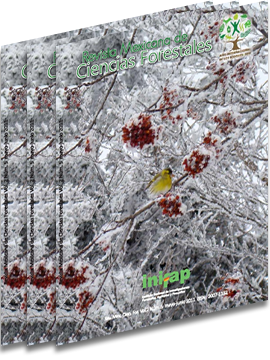EARLY GROWTH IN SEEDLINGS FROM TWELVE PROVENANCES OF Pinus hartwegii Lindl. IN NURSERY CONDITIONS
DOI:
https://doi.org/10.29298/rmcf.v2i5.584Keywords:
Nursery growth, Desierto de los Leones, Pinus hartwegii, provenances, Valle de Mexico, population variabilityAbstract
Pinus hartwegii is widely distributed in Mexico and even reach the Republic of El Salvador in Central America. The populations of this species in the central region of Mexico are located in the highest zones of the mountain ranges, commonly designated as natural protected areas, important generators of ecosystemic services to the society. Studies related to variation among provenances of P. hartwegii had been developed, especially in cones and leaves morphology, as well as seed characteristics. Variation in the initial growth among seedlings of different provenances growing in nursery conditions has never been determined. This response was evaluated in 12 provenances from the mountain range named Eje Neovolcánico that cross Mexico from east to west and an experimental design of random blocks with 56 repetitions from each provenance was used. The parameters measured in the seedlings were basal diameter and height, in addition to the growing rates of these variables in a period of 10 months. Seedlings from the population of Cofre de Perote showed the most extreme values among provenances in these variables and were significantly different. However, the groups defined after the statistical analysis do not allow the identification of any geographic pattern related to a latitudinal or longitudinal gradient, and the variation found among the provenances of this species could be related to local conditions in which the populations developed and drive the selection process in those individuals.
Downloads
Downloads
Published
How to Cite
Issue
Section
License
The authors who publish in Revista Mexicana de Ciencias Forestales accept the following conditions:
In accordance with copyright laws, Revista Mexicana de Ciencias Forestales recognizes and respects the authors’ moral right and ownership of property rights which will be transferred to the journal for dissemination in open access.
All the texts published by Revista Mexicana de Ciencias Forestales –with no exception– are distributed under a Creative Commons License Attribution-NonCommercial 4.0 International (CC BY-NC 4.0), which allows third parties to use the publication as long as the work’s authorship and its first publication in this journal are mentioned
The author(s) can enter into independent and additional contractual agreements for the nonexclusive distribution of the version of the article published in Revista Mexicana de Ciencias Forestales (for example, include it into an institutional repository or publish it in a book) as long as it is clearly and explicitly indicated that the work was published for the first time in Revista Mexicana de Ciencias Forestales.
For all the above, the authors shall send the form of Letter-transfer of Property Rights for the first publication duly filled in and signed by the author(s). This form must be sent as a PDF file to: ciencia.forestal2@inifap.gob.mx
This work is licensed under a Creative Commons Attribution-Noncommercial 4.0 International license.






